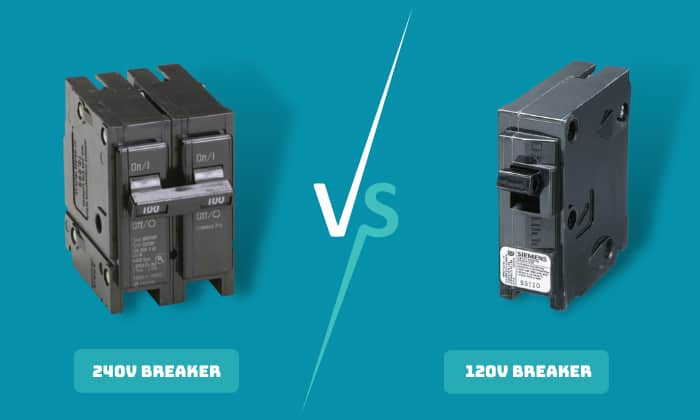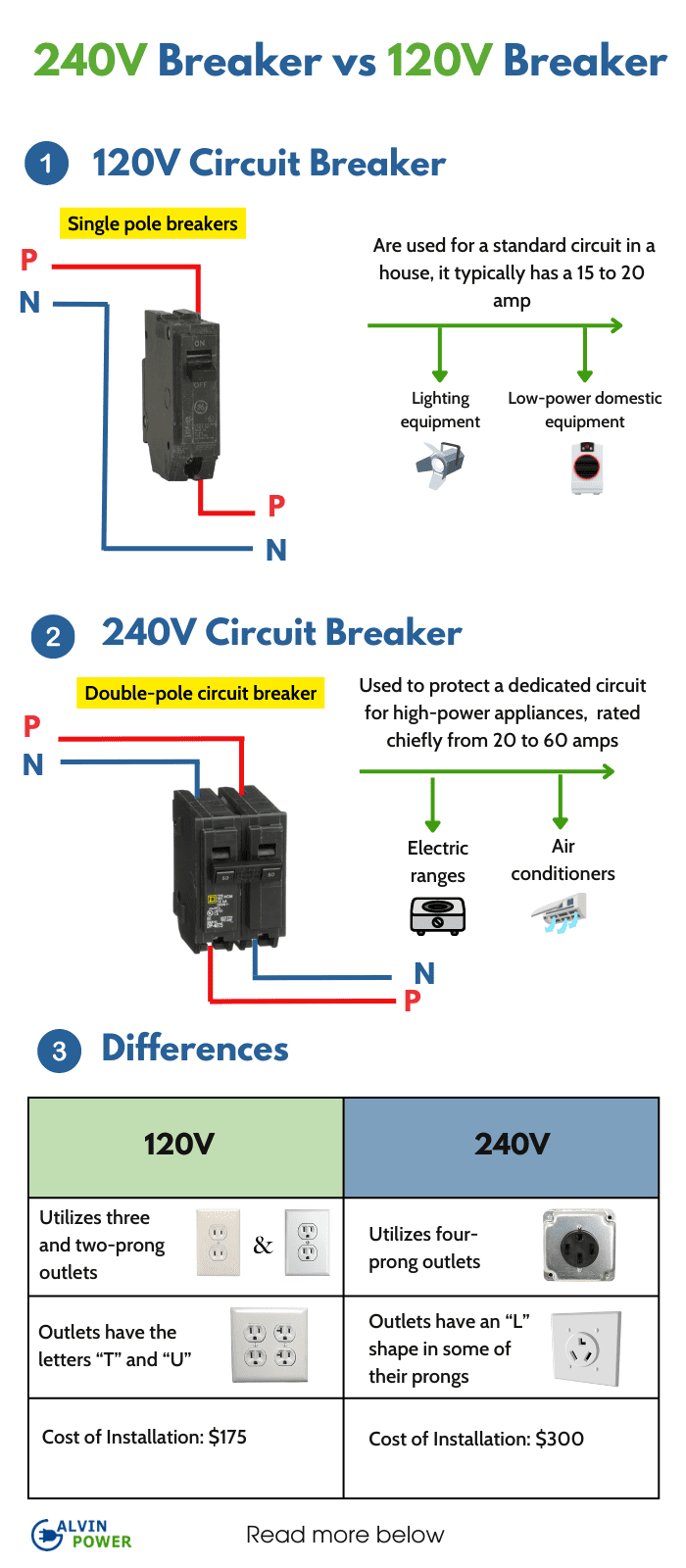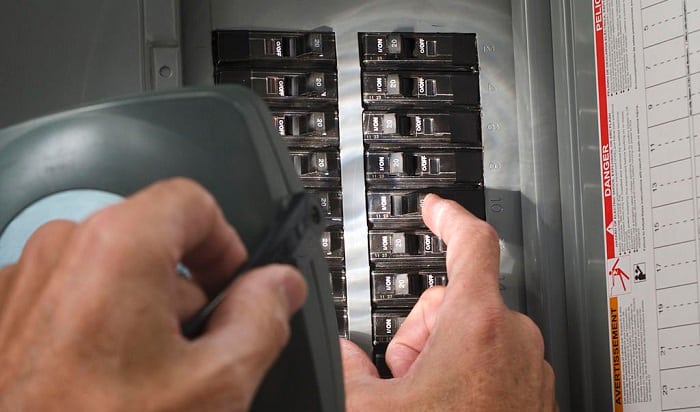Generally, an average residential house has 120V and 240V circuits to run various appliances and equipment. To protect these power supplies, we also utilize single-pole and double-pole breakers.
A single-pole circuit breaker can provide 120 volts, while a double-pole one can provide 240 volts.
If you want to learn more about 240v breaker vs 120v breaker, check out the comparison below.
Table of Contents
120V Breakers vs 240V Breakers
What is a 120V Circuit Breaker?
120V circuit breakers, often called single pole breakers, are used for a standard circuit in a house. It typically has a 15 to 20 amp rating to offer service to most lighting and other low-power domestic equipment.
Normally, a 120V circuit breaker only occupies one load center slot. However, there is also a tandem breaker that has the same size as a single pole breaker and utilizes one slot in the load center as well.
This tandem breaker is a dual 120V CB and is frequently used when there is insufficient space in load centers for a new circuit. This device is not the same as a double pole breaker that can provide 240V service, as it serves two 120V lines instead of one 240V supply.
How Does 120V Work?
A load center has two main bus bars, each with a power of 120V that comes from a transformer. In this case, a 120V circuit breaker uses one hot bus bar and two wires, or hot and neutral connections.
However, as time passes, NEC standards have evolved and require a third wire for grounding to ensure additional safety.
What is a 240V Circuit Breaker?
A circuit breaker 240V is also known as a double-pole circuit breaker. It is mainly used to protect a dedicated circuit for high-power appliances such as electric ranges, air conditioners, and more.
This breaker is rated chiefly from 20 to 60 amps. Since a 240V breaker is as big as two 120v breakers, it takes up two places in a load center.
Some manufacturers put the 240V breaker’s bridge switch inside the device. In this case, you may find some double pole circuit breakers with only one switch.
How Does 240v Work?
As previously mentioned, a load center has two 120V main bus bars, which are used by a double-pole circuit breaker to provide a 240V power supply.
Essentially, three wires are used to get 240V at home circuit line. These eventually become four according to NEC standards. They include two hot wires, a neutral wire, and a ground wire.
Differences Between 1 Pole vs 2 Pole Breaker
Obviously, the main difference between a 120/240 Volt Breaker is the supply they can provide and their construction. Furthermore, these devices also have wiring differences, which can be identified by looking into outlets.
Modern 240V breaker wiring generally utilizes four-prong outlets, while a 120v circuit utilizes three and two-prong outlets.
240V outlets also have an “L” shape in some of their prongs. In contrast, modern 120v outlets have the letters “T” and “U”.
Pros and Cons of 240V and 120V Breakers
- Both trip to protect appliances and homes against electrical faults and fires.
- Both can be reset to restore energy to equipment.
- Regarding the disadvantages, both breaker types can decline with age and only suit devices that are compatible with their ratings.
Cost of Installation
There could be a significant variation in the cost of installing a 120/240 VAC outlet. A 120V outlet could set you back an average of $175. Meanwhile, a 240V receptacle can cost an average of $300.
When you DIY the installation of any circuit in a 240V or 120 amp panel, you can save money. However, it’s necessary to have a wiring diagram for easy setup.
If you are uncomfortable, lack confidence and expertise, or have a strong fear of electricity, seeking a professional to do the job is recommended.
Recommend posts to read:
FAQs
How Do I Know if a Circuit Breaker is 120 or 240?
When you look into your breaker box, you can easily identify if a circuit breaker is 120v or 240v. A 120v circuit breaker only occupies one space or slot in the panel, while a 240v breaker takes up two openings.
Can I Use 2 120V Breakers for 240V?
Yes, you can use two 120V breakers to make a 240V circuit. However, getting 240 volts from 120 electrical connections is not recommended as it has a high risk of electrical faults that can damage your property.
What Breaker is Needed for 240V?
To know what breaker size is best for your 240V circuit, you should first compute your device’s total amp rating. Moreover, it would be best if you also considered the 80% electrical rule.
For the computation, identify the total wattage of your device, then divide it by its voltage rating. After that, you must multiply the result by 1.25 to apply the 80% rule and get the amperage for your breaker.
For example, a 5000-watts device with a 240 volts rating uses 20.83 amps; 20.83 x 1.25 = 26.04 amps.
A 25-amp circuit breaker will be insufficient, and there’s no product that matches the exact rating we got. Therefore, we’ll need a 30-amp breaker for this 240v circuit.
Recommended article to read:
How to Tell if a Circuit is 120 Or 240?
For new house circuit installation, a 240V circuit utilizes four wires while a 120V one only has three wires. However, if you want to ensure the electrical loads are appropriate for the circuit, you can use a multimeter to test it.
Set your multimeter to AC and check your outlet. If the circuit run a 240 volt line, you can get a reading of an average of 240v in your multimeter.
Conclusion
When it comes to a 240v breaker vs 120v breaker, both are useful. They help protect your low-power and high-power devices in a residential environment.
Installing a circuit with a load service of 120V or 240V can be done quickly. However, it is ill-advised to create any experimental electrical connections as they may cause damage to your property.

I am Edwin Jones, in charge of designing content for Galvinpower. I aspire to use my experiences in marketing to create reliable and necessary information to help our readers. It has been fun to work with Andrew and apply his incredible knowledge to our content.



